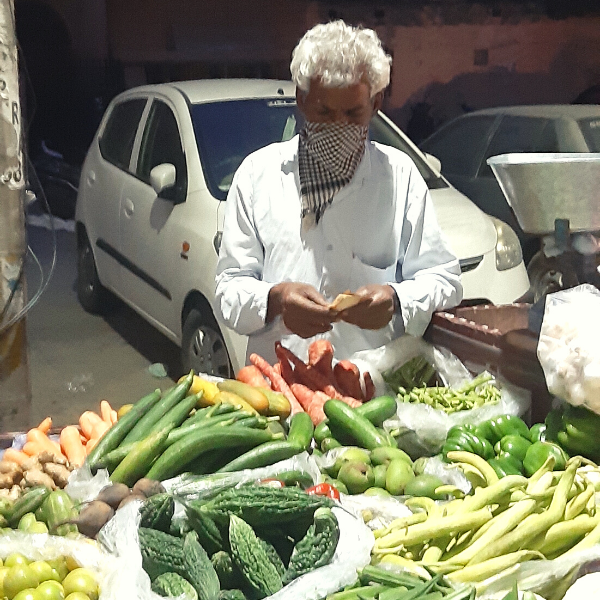This blog is part of the COMPAS Coronavirus and Mobility Forum.
The time is 6pm. I hear the incessant shouting of Ram Naresh bhaiya, our neighbourhood sabziwala (vegetable vendor), shattering the Delhi summer evening schtum, alerting the inhabitants of a sluggish neighbourhood to his arrival: “Taazi! taazi sabzi! gajar! aloo aur matter!” (Fresh vegetables: carrots, potatoes and peas). The sound of his shouts slowly fade out as he circles the other adjacent block chanting the same haunting one liner. After another 15 minutes, I hear him clearly again when he parks his cart right outside my doorstep.
On a usual day, Ram Naresh bhaiya earns a total of 2000 rupees (approx. £20.00) from the sale of his fresh vegetables. However, these days he barely makes ends meet since his regular customers have stopped venturing outside their homes to purchase vegetables from him, choosing instead home delivery through the corporate giant Big Basket.
This is my home now
Ram Naresh has been selling vegetables in our neighbourhood for 10 years. “This is our home now. If I do not shout here (to sell vegetables) then I do not feel good”, he says. He is the only sabziwala in my neighbourhood who would give me a 5 rupee bargain on almost each vegetable, even onions! Moreover, he would always throw in the complimentary dus rupay wala dhaniya (coriander), amounting to 1p.
Ram Naresh bhaiya hails from Shahjahanpur district in Uttar Pradesh and currently puts up in a one bedroom rented accommodation in a place about 15 minutes away from our locality. He shares his small room with his three daughters and his wife, for which he pays 3000 rupees (approx. £30.00) per month. He chose that place because it is close to Azadpur Mandi, one of the largest fresh fruits and vegetables market in Asia. Every morning, including on Sundays, he leaves home at 7:30 am for Azadpur mandi to purchase his daily wares. From Azadpur Mandi he then travels to Roop Nagar in a tuk-tuk (a battery operated auto rickshaw) to retrieve his parked thela which he pushes to our locality.
I will definitely come back
I was able to meet Ram Naresh bhaiya before he left for his home in Shahjahanpur. He confides in me that he does not want to go back to Shahjahanpur. “There is nothing left back in the village”. Ten years ago, he barely managed to earn about 50 rupees daily by working on his field. However, he was needed back home because his younger brother was not well, and someone was needed to tend to their land. Instead of joining the transport organized by Uttar Pradesh state government to bring migrants home, Ram Naresh bhaiya rented a private car to take the family back to Shahjahanpur. He had to pay 11000 rupees (approx. £100.00) to a private car hiring agency, spending most of his savings. I asked him when he is returning to Delhi, He replied “I will come back, definitely will come back maybe in another month”.
Before parting I asked “If I write about you, will you feel bad?” He replies with a giggle, “Why will I feel offended, do write!”
Understanding choice, understanding home making practices
Ram Naresh bhaiya’s voice piercing through the neighbourhood not only made us, (a privileged few), aware of his presence, but also of his choice to stay back in the city and to work here to escape economic vulnerability back home even during the lockdown period. His three daughters who moved to Delhi along with Ram Naresh bhaiya ten years ago study in the neighbourhood government school. By affirming his desire to stay back and his willingness to come back after some time, he asserts the he cannot possibly dissociate himself from the city despite being confronted by a pandemic. Perhaps this refusal to dissociate also stems from the fact that he is aware of the vulnerability that awaits them back at home once they reach their respective states of origin.
Home making practises in metropolitan cities are processes when migrant workers build networks with people whom they meet in their daily lives on the move. These fictive kinships in return blur the distinction between the home (their origin state) from which they migrate and the home (Delhi in this case) to which they migrate. Mobility for migrant workers/vendors is also governed by choices and home making practices which remains unchallenged even in the face of the harshest of pandemics. When the public media is flooded with images of stranded migrants on their desperate journeys to home, it is important to remember that there are many migrants choose to stay put. From Ram Naresh bhaiya’s account what is intriguing is the continuity of everyday life which is deeply embedded in the home making practices.
Shivangi Kaushik is a DPhil student in International Development, University of Oxford
